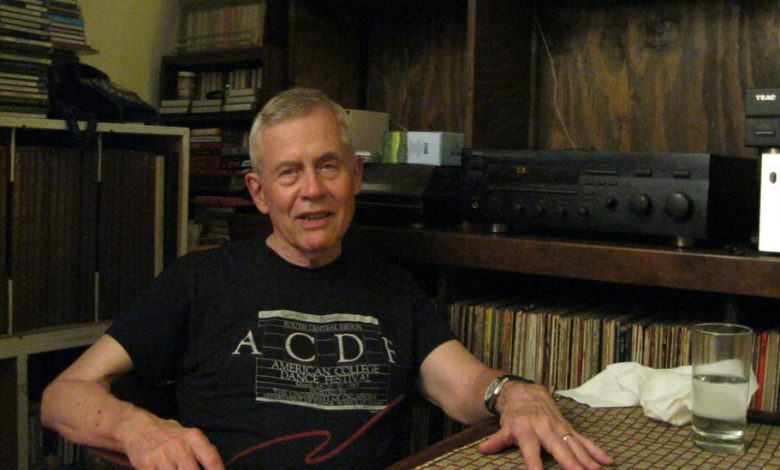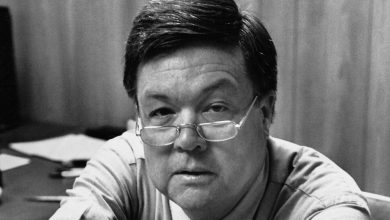Jack Anderson, Longtime Dance Critic for The Times, Dies at 88

Jack Anderson, a writer on dance for The New York Times for about five decades who combined a historian’s learnedness with an enthusiast’s ardor for what was new and surprising, died on Friday in Manhattan. He was 88.
His death, at a hospital, was confirmed by his husband and sole survivor, George Dorris, who said the cause was sepsis.
Mr. Anderson, who wrote about 4,000 essays, reviews and other articles for The Times, found an opportunity to expound his philosophy of dance in 1990.
Some viewers had objected to two recent shows of New York City Ballet — “Watermill,” a 1972 work by Jerome Robbins, and “A Mass,” a new work by Peter Martins and Robert LaFosse — on the grounds that these productions, featuring oddly slow or repetitive movements, were not ballet — and not even really dance.
Mr. Anderson offered a definition of his own: “Dances are what choreographers create and dancers perform; ballets are created by ballet choreographers.”
Labels like “ballet” are simply requests by choreographers for their work to be viewed as belonging to a certain set of traditions, Mr. Anderson argued.
Those who claimed that the two shows were somehow not dance, he continued, seemed to be confusing dance with virtuosic movement.
“Although dancing can — and frequently should — dazzle, dance should never be equated with virtuosity alone,” Mr. Anderson wrote. “Anything a dancer does onstage is dancing.”
Mr. Anderson brought that all-embracing point of view to his criticism. He took issue both with “abstractionists who believe that dance is virtually predestined to grow abstract” and “proponents of dance-drama” who “consider abstraction frivolous or even pointless.”
He did consider himself a partisan of modern dance, describing it in a 1983 article as the form that had “consciously affirmed the dignity of dance as an art.” He also wrote ardently about tap, the comic theater of Japanese Kyogen dancing, Odissi religious dance of East India and practically every other genre.
Mr. Anderson did not even need to believe that he understood something to approve of it. In a 1992 review of “Havoc,” a work by the choreographer Bill T. Jones, Mr. Anderson wrote: “Whatever allegorical significance Mr. Jones intended his choreography to have was not clear on a first viewing. Yet its sheer intensity made the piece compelling rather than puzzling.”
Mr. Anderson’s lack of doctrine meant that at different times he would argue apparently opposing positions.
In 1990, he objected to a “Romeo and Juliet” ballet by Kenneth MacMillan for staging “cavortings” without any point of view, merely telling “an old tale without investing it with new life.” Yet in 1981 he wrote an essay criticizing attempts to alter balletic classics, arguing that often these works wound up crowded by “extraneous details.”
What Mr. Anderson wanted consistently was boldness.
Writing in 1991 on the tendency of male choreographers to adopt an athletic style that seemed to “insist upon their masculinity,” Mr. Anderson wrote in support of “Brides of Frankenstein,” a dance piece by Rick Darnell with men in tutus.
It was “a silly romp,” he wrote, but its “tomfoolery” had the virtue of showing that “men need not be unremittingly solemn in all-male dances.”
Mr. Anderson continued in exhortation: “Let there be more all-male dances in which the performers portray saints, sinners, clowns, fools, lovers, haters, visionaries, bumblers, idealists, maniacs and ordinary citizens. Let this choreography be lyrical, bumptious, reverent, elegant, earthy, sassy and as unpredictable as life itself.”
Jack Warren Anderson was born on June 15, 1935, in Milwaukee. His mother, Eleanore (Force) Anderson, worked as a hospital administrator, and his father, George, was a movie projectionist.
In the late 1950s, Mr. Anderson earned a bachelor’s degree in theater from Northwestern University and a master’s in creative writing from Indiana University. He began working as a drama and dance critic around 1960 and spent several years on the staff of Dance magazine.
He became a dance critic for The Times in 1978 and remained in that position until 2005. Afterward, he kept writing for the paper as a freelancer; his most recent piece, an obituary about the dancer and choreographer Anna Halprin, was published in 2021.
He also wrote poetry and books about dance history.
On Feb. 12, 1965, Mr. Anderson was on a subway platform near Lincoln Center in Manhattan reading the program for George Balanchine’s “Liebeslieder Walzer” after seeing the production. Mr. Dorris, who had also just seen the ballet, approached Mr. Anderson and struck up a conversation. The two men took the subway downtown and got coffee.
They were a couple for 58 years, marrying in 2006 and sharing a Greenwich Village apartment. In 1977 they co-founded Dance Chronicle, a scholarly journal that they also coedited. It is currently seeking submissions for a 2024 issue.




